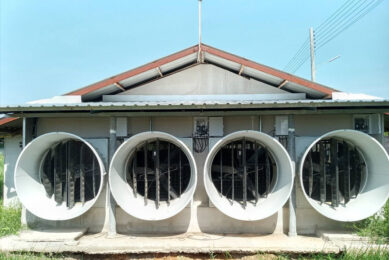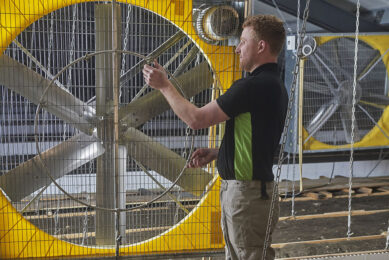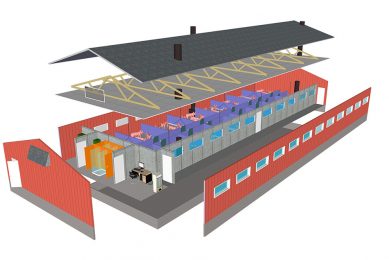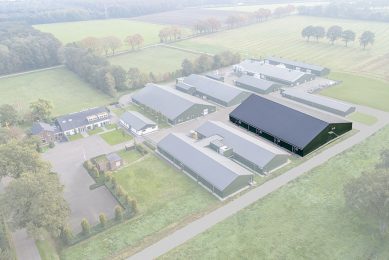Air movement

Many of my call-outs involve ventilation problems. Quite a few farmers, particularly those with piggery ventilation which is older and needing improvement, are less informed about how air moves inside a building and its importance to profit and pig welfare. When things are explained on the spot and some simple demonstrations done to back up the advice, most remark, “I see now.” A few go on to say, “Why don’t the textbooks explain it like that?” Okay, lets go down a path or two.
How air moves
Piggery air rarely moves in straight lines but in a series of rotary patterns of ripples, bubbles and swirls, which move throughout the enclosed spaces in patterns. These are dictated by inlet speed, incoming air temperature, obstructions, internal surfaces and warm or cold areas inside the structure. We all know that hot air rises and cold air falls. An important source of heat being the pigs themselves, heat which you have provided mainly from the food which you have paid for. For example ten 50 kg pigs produce as much heat as a 1 kW electric fire. The passage of air across a pig removes heat from its thermal envelope – a good thing when things get too hot but it can be costly at other times and disease-threatening if it chills the pig.
Many causes of problems caused by incorrect air movement arise from farmers thinking that they cannot ‘see’ air movement, only ‘feel’ it. But you can see it. Perfectly easily!
Ten years ago I did a survey on some 28 farms with ventilation problems. Only one had chemical smoke phials/ tubes, none had even heard of a hand-held anemometer, while four admitted to using cigarette smoke as a rough indicator but only on relatively still air movement conditions. Keep your eye open at the expos and fairs for the first two and enquire from the equipment suppliers if you don’t see them. Then learn to use them to trace air patterns, vigorous or gentle, which is an absorbing procedure in the all-important grow-out barns where incorrect ventilation erodes a great deal of your food conversion profit. You really can help yourselves here and don’t need an expert to visit.
Why is ‘seeing’ air so important?
Generally speaking, when a pig is in its ‘comfort zone’ and piling on the profit for you, we want the air to cross it at no more than 0.2 m/ second. Roughly. This speed will minimise the heat loss from say 5 kg onwards. This is 5 seconds to cross one metre. Pass your hand across a distance of one metre taking 5 seconds to do it. Slow, isn’t it! An airspeed across the pigs back of under 0.2 m/ sec will not constitute a draught unless the air is very cold, when you may need to warm it up for small pigs.
As the pig gets warmer and approaches its evaporative critical temperature (ECT), passing air over it (even warmish air) will remove the thermal envelope and 1 m/ sec will do this effectively, less so if the air is warm and moist but more effectively if the pig’s skin has been wetted due to the evaporative cooling effect.
A very rough but quite useful method of detecting where air is moving, is copiously to wet the back of your hand or lower arm. Due to the air evaporating moisture lowering the surface temperature on the skin, this wetting of your skin will detect low air speed currents just above the 0.2 m/ sec threshold. I’ve had this simple idea tested against an anemometer at an engineering research station and it proved accurate enough to be useful.
Smoke diffusion tubes which emit harmless white smoke when air is blown through them by a detachable rubber bulb are useful for close work around creep areas and especially over surfaces prone to condensation. For larger areas a hand-held liquid fog generator is invaluable although you need to be sparing with the smoke. I carry all this kit with me in the car and it soon reveals any incorrect air patterns and speeds – too much or too little. I think I have done more good – anyone can – with these demonstrations in opening stockpersons’ eyes to what air placement is all about than from writing pages of advice like this over the years.
What the pigs are telling you
One of the best tools for detecting the effects of wrong air placement are the pigs themselves. The way they behave is a major ‘instrument’ in itself, especially when piling or huddling is noticed and in hot sows, panting. Become expert at noticing unusual lying behaviour, urinating in normally dry areas and wrong mucking, then act on what the pigs are telling you about incorrect air placement which will largely be responsible for it.
Lesson learned – what a draught does
Not long after I left college and was working as the most junior of juniors on an experimental pig farm, I was persuaded, despite understandable reluctance on my part, to spend the better part of a night in what I thought was a fairly warm, but empty, pig pen just dressed in my pyjamas. The wise old piggery manager wanted to show me how cold a night-time draught could be. In this case it was a very slight fall of coolish air down the side of the pen wall against which I had placed my Dunlopillo mattress, sans coverlet. This was not noticeable or particularly disturbing for 30 minutes or so, but from then on it was enough of a discomfort to prevent sleep. Within three hours I had a real stiff neck! Ever since then I advise nailing a 4 cm right-angle batten strip to an end wall against which pigs may lie during the night. This deflects any down-draught outwards to be mixed with the warm air rising from the sleeping pigs so that those next to the wall get a good draught-free nights rest! Simple and cheap.
[Source: Pig Progress magazine Vol 29 nr 9, 2013 – ‘What the textbooks don’t tell you about…’ series]











